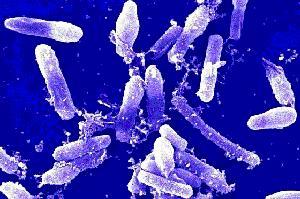Bacillus cereus: Difference between revisions
| Line 57: | Line 57: | ||
[http://www.ncbi.nlm.nih.gov/sites/entrez?Db=genomeprj&cmd=ShowDetailView&TermToSearch=19959 [1]] | [http://www.ncbi.nlm.nih.gov/sites/entrez?Db=genomeprj&cmd=ShowDetailView&TermToSearch=19959 [1]] | ||
"''Bacillus cereus.''" NCBI website. Accessed on August 18, 2007 | "''Bacillus cereus.''" NCBI website. Accessed on August 18, 2007 | ||
[http://www.pubmedcentral.nih.gov/articlerender.fcgi?tool=pmcentrez&artid=1489341[2]] | |||
Vilain, S., Luo, Y., Hildreth, M., and Brozel, V. “Analysis of the Life Cycle of the Soil Saprophyte ''Bacillus cereus'' in Liquid Soil Extract and in Soil.” Applied Environmental Microbiology. 2006. Volume 72(7). p. 4970–4977. | |||
[http://www.pubmedcentral.nih.gov/articlerender.fcgi?tool=pmcentrez&artid=1563598 [3]] | |||
DelVecchio, V., Connolly, J., Alefantis, T., Walz, A., Quan, M., Patra, G., Ashton, J., Whittington, J., Chafin, R., Liang, X., Grewal, P., Khan, A., and Mujer C. “Proteomic Profiling and Identification of Immunodominant Spore Antigens of ''Bacillus anthracis'', ''Bacillus cereus'', and ''Bacillus thuringiensis.”'' Applied Environmental Microbiology. 2006. Volume 72(9). p. 6355–6363. | |||
[http://www.cfsan.fda.gov/~mow/chap12.html[4]] | |||
''“Bacillus cereus.”'' United States Food and Drug Administration, Center for food safety and applied nutrition (FDA). Accessed August 18, 2007. | |||
[http://www.pubmedcentral.nih.gov/articlerender.fcgi?tool=pmcentrez&artid=1594744 [5]] Hoffmaster, A., Hill, K., Gee, J., Marston, C., De, B., Popovic, T., Sue, D., Wilkins, P., Avashia, S., Drumgoole, R., Helma, C., Ticknor, L., Okinaka, R., and Jackson, J. “Characterization of ''Bacillus cereus'' Isolates Associated with Fatal Pneumonias: Strains Are Closely Related to ''Bacillus anthracis'' and Harbor ''B. anthracis'' Virulence.” Journal of Clinical Microbiology. 2006. Volume 44(9). p. 3352-3360. | |||
Edited by Jacqueline Nguyen student of [mailto:ralarsen@ucsd.edu Rachel Larsen] | Edited by Jacqueline Nguyen student of [mailto:ralarsen@ucsd.edu Rachel Larsen] | ||
Revision as of 00:54, 27 August 2007
A Microbial Biorealm page on the genus Bacillus cereus
Classification
===Higher order taxa===

Domain: Bacteria
Phylum: Firmicutes
Class: Bacilli
Order: Bacillales
Family: Bacillaceae
Genus: Bacillus
Species Group: Bacillus cereus group
Species
|
NCBI: Taxonomy |
Bacillus cereus
Description and significance
Describe the appearance, habitat, etc. of the organism, and why it is important enough to have its genome sequenced. Describe how and where it was isolated. Include a picture or two (with sources) if you can find them.
Genome structure
Describe the size and content of the genome. How many chromosomes? Circular or linear? Other interesting features? What is known about its sequence? Does it have any plasmids? Are they important to the organism's lifestyle?
Cell structure and metabolism
Describe any interesting features and/or cell structures; how it gains energy; what important molecules it produces.
Ecology
Describe any interactions with other organisms (included eukaryotes), contributions to the environment, effect on environment, etc.
Pathology
How does this organism cause disease? Human, animal, plant hosts? Virulence factors, as well as patient symptoms.
Application to Biotechnology
Does this organism produce any useful compounds or enzymes? What are they and how are they used?
Current Research
Enter summaries of the most recent research here--at least three required
References
[1] "Bacillus cereus." NCBI website. Accessed on August 18, 2007
[2] Vilain, S., Luo, Y., Hildreth, M., and Brozel, V. “Analysis of the Life Cycle of the Soil Saprophyte Bacillus cereus in Liquid Soil Extract and in Soil.” Applied Environmental Microbiology. 2006. Volume 72(7). p. 4970–4977.
[3] DelVecchio, V., Connolly, J., Alefantis, T., Walz, A., Quan, M., Patra, G., Ashton, J., Whittington, J., Chafin, R., Liang, X., Grewal, P., Khan, A., and Mujer C. “Proteomic Profiling and Identification of Immunodominant Spore Antigens of Bacillus anthracis, Bacillus cereus, and Bacillus thuringiensis.” Applied Environmental Microbiology. 2006. Volume 72(9). p. 6355–6363.
[4] “Bacillus cereus.” United States Food and Drug Administration, Center for food safety and applied nutrition (FDA). Accessed August 18, 2007.
[5] Hoffmaster, A., Hill, K., Gee, J., Marston, C., De, B., Popovic, T., Sue, D., Wilkins, P., Avashia, S., Drumgoole, R., Helma, C., Ticknor, L., Okinaka, R., and Jackson, J. “Characterization of Bacillus cereus Isolates Associated with Fatal Pneumonias: Strains Are Closely Related to Bacillus anthracis and Harbor B. anthracis Virulence.” Journal of Clinical Microbiology. 2006. Volume 44(9). p. 3352-3360.
Edited by Jacqueline Nguyen student of Rachel Larsen
